The golf course
The best golf location in Granada
From most of its holes you can contemplate splendid panoramic views. It is common to take as reference points for the game, some of the most picturesque and characteristic enclaves of the city: the Torre de la Vela, Alfaguara, Veleta, Pico del Caballo, etc. In general, it is a technical and demanding course, but it allows the different handicap categories to enjoy the game. There are some very difficult holes, such as the 5th, where, when standing on the tee, it is inevitable to feel a certain nervousness. Others, however, make it relatively easy to recover strokes, such as holes 6 and 9. There are water hazards, such as the lakes on holes 5, 16 and 17, which are also water reservoirs for irrigation.
In the center of the course, and at its highest point, is the clubhouse, from which almost the entire course can be seen.
Hole by hole

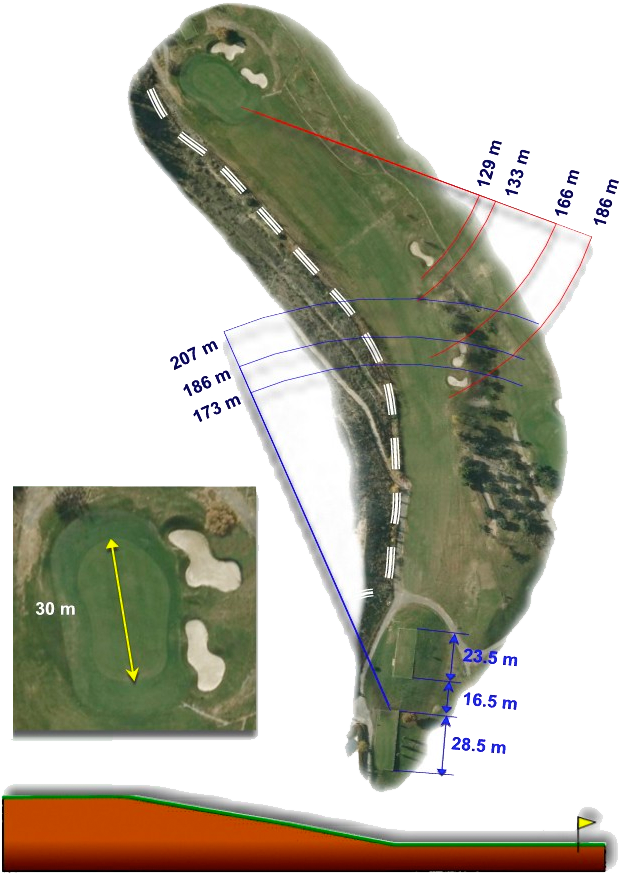
Hole 1
Par four with dog leg left and downhill. A somewhat tense hole to start with an out of bounds on the left and a lateral water hazard on the right. The shot to the green does not usually present any problem as long as we have taken the fairway from the tee, only a couple of bunkers located to the right of the green both can complicate the result. Perhaps the solution would be to assume that it is not the best hole to make birdie and leave happy with a good par.

Hole 2
Par three with out of bounds on the left. Two bunkers, one occupying the right half of the entrance to the green and the other located at a height on the same side complicate the shot to the green. If we have gone out cooler than we should, the lateral water hazard located at the exit of the 17th hole may come into play.
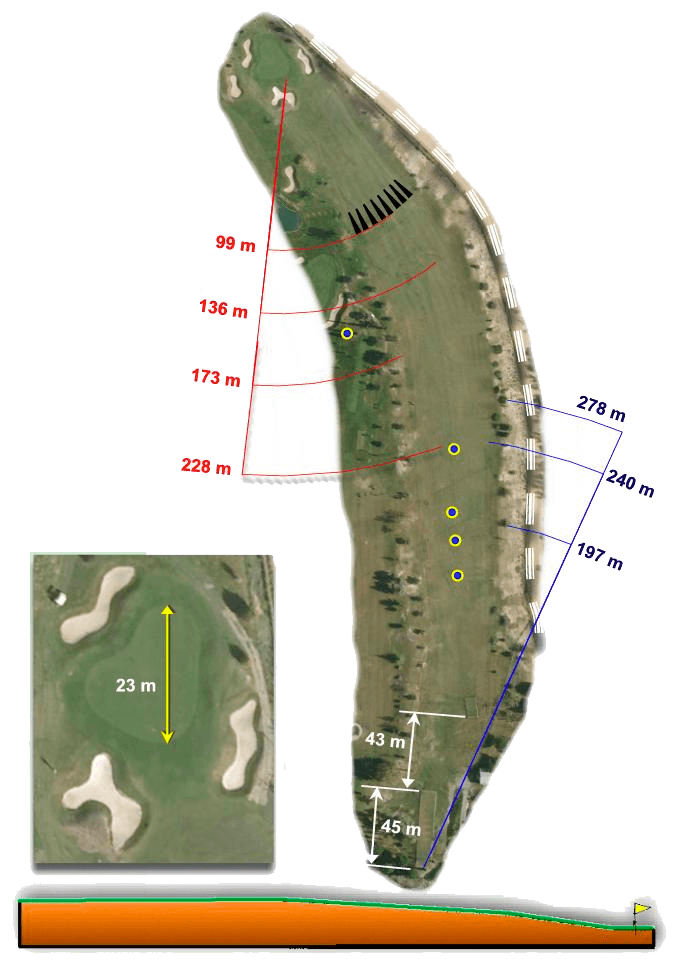
Hole 3
Par five with dog leg left and downhill shot to the green. It should not present any complication if you are a draw player, since along the whole hole on the right side, a goat path fenced with metal fence and declared out of bounds can play a joke on us and add two more strokes to our long-suffering result. The shot to the green is beautiful, as if it were a painting, isn’t it? Three bunkers, one occupying the left side of the entrance and another just to the right form a gorge that could help us if we intend to roll in. The third bunker is located a little too far to the left, penalizing those who seek the flag on this side as there is little space between it and the entrance bunker. Beware of the slice and those who graze to the right of the green, the course insurance does not cover damage to horses.
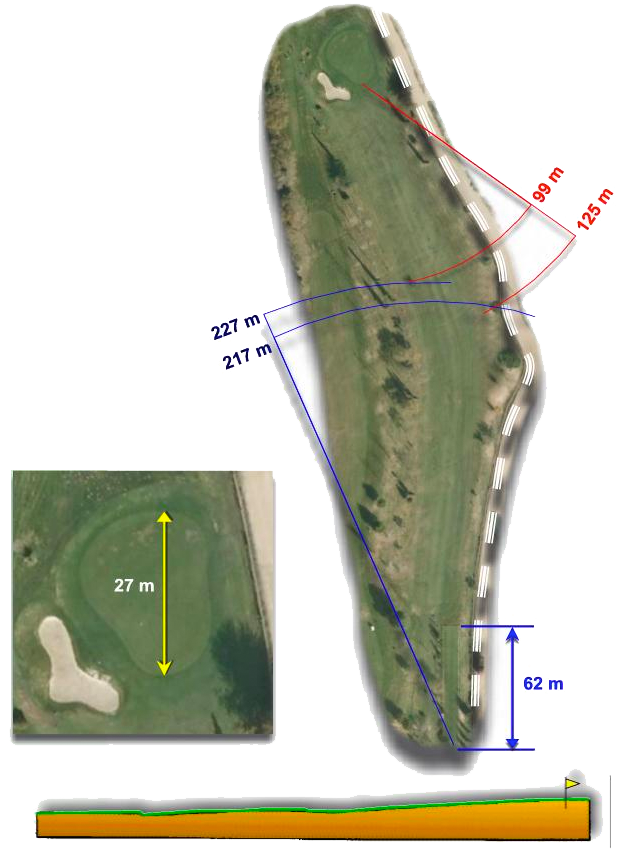
Hole 4
Par four with dog leg to the left. As you will see on the tee the path continues and the whinnies as well, remember that it is still out of bounds. On the shot to the green the path gets too close, closer than it seems, so much so that if the ball bounces just two meters from the green on the right, you may have problems with the metal fence and the successive drop shots that you will have to make. A bunker that occupies part of the entrance and the left side of the green can bother us if the flag is located just on this side.
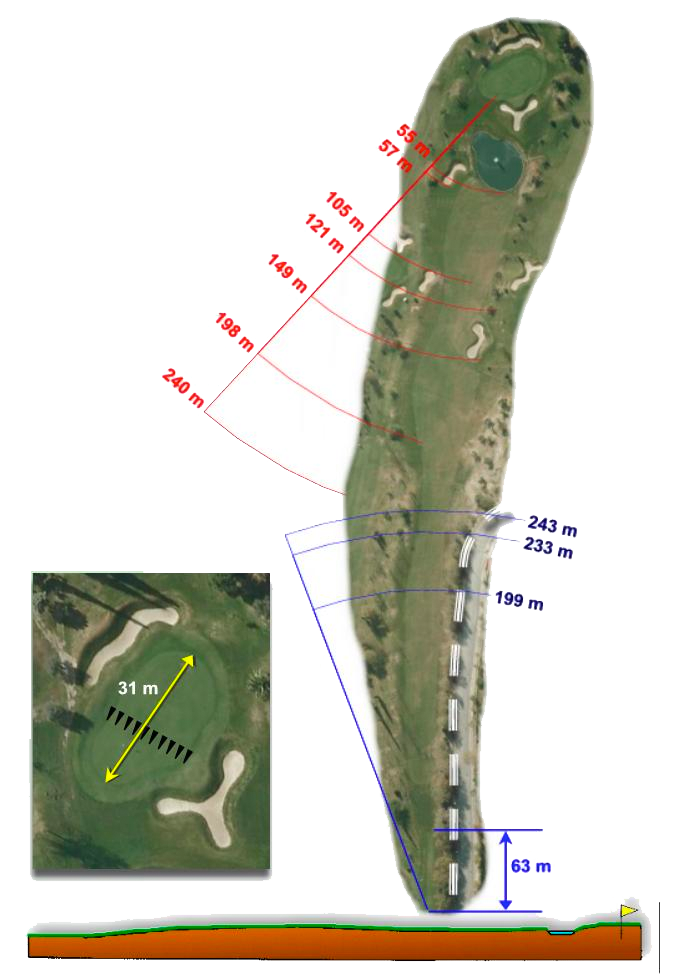
Hole 5
Par five with dog leg to the right. The row of trees located on the right side hide an out of bounds that comes into play more often than expected, maybe the slope that delimits the course and the road will save us from the penalty. The shot to the green will be full of obstacles starting with a frontal water hazard and followed by two bunkers, one located at the entrance and the other protecting the left bottom of the green. A piano from side to side divides the green into two parts, the lower part narrower and shorter and the upper part wider and deeper.
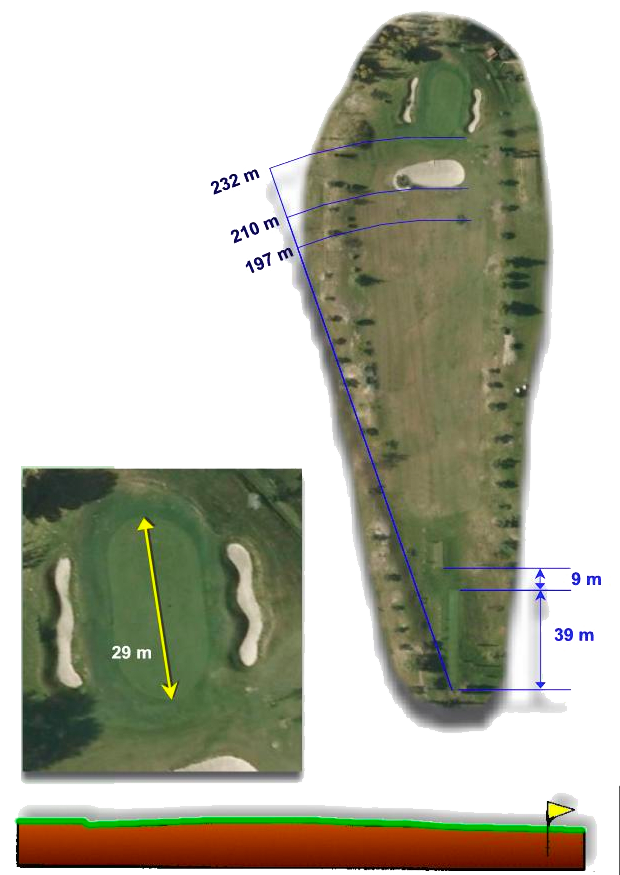
Hole 6
Short par four but with a blind tee shot. I don’t want to put pressure on you but there are few birdie holes and this is one of them. Only three bunkers, one located at the entrance which in turn can also bother on the tee, two located on both sides of the green, an out of bounds at the back and a couple of olive trees at the height of the entrance bunker can prevent us from leaving the next one with a stroke less.
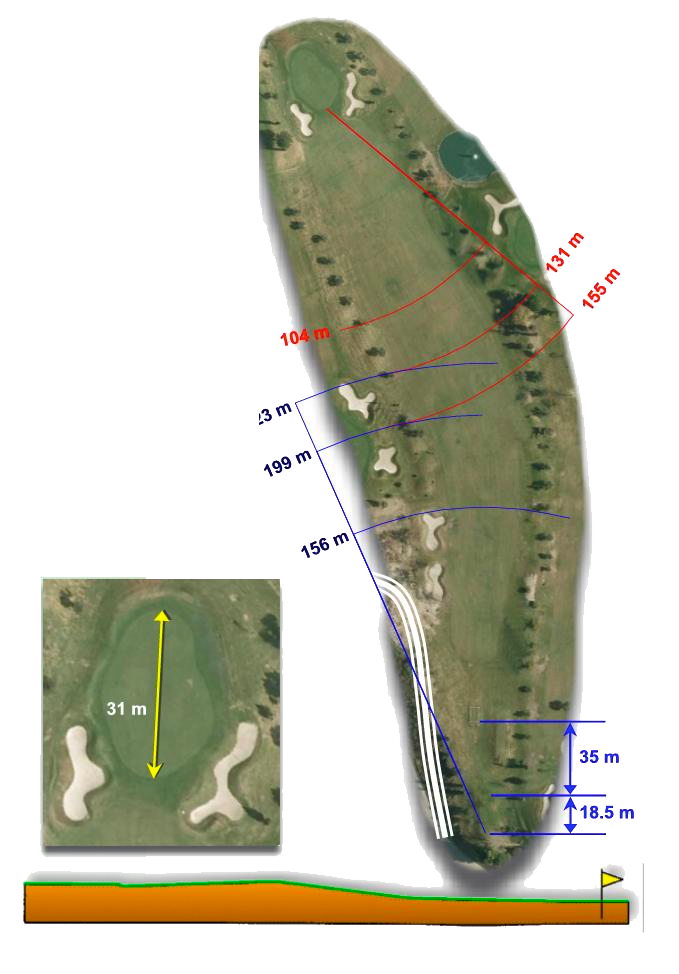
Hole 7
Par four with dog leg to the left. At the tee there are two bunkers on the left side of the fairway and an out of bounds even further left. A couple of meters can be gained from the driver if the ball reaches the downhill slope located about 140 meters from the green. If it gets downhill, the second shot will be straightforward with only two bunkers on either side of the green as the only obstacles. If the ball does not reach the bottom on the tee, it is not a bad option to try to roll in, bearing in mind that the fairway slopes to the right.
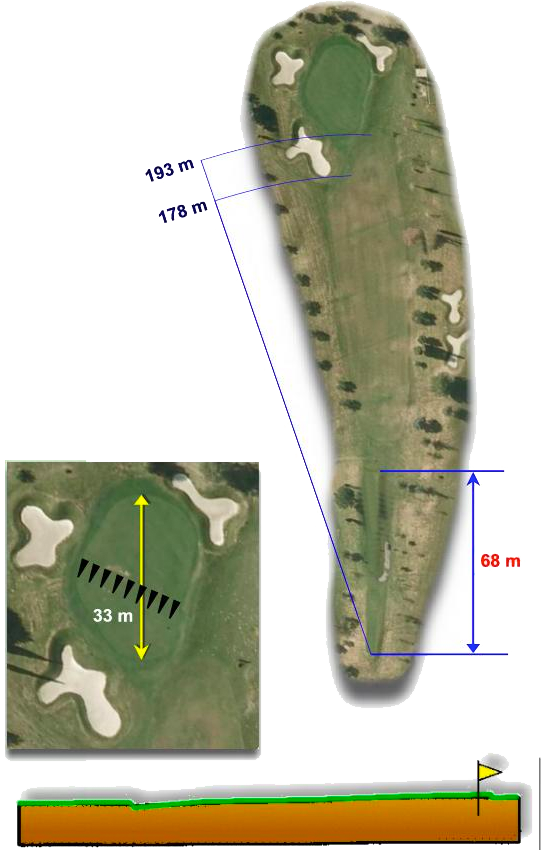
Hole 8
Straight par three. Three bunkers, two of them very deep, located at the entrance on the left and at the height on the same side protect the shot to the left side of the green, and another one located at the back on the right that will only come into play if the flag is long. Out of bounds past the green, although there is a space of about 30 meters to save us in case we have chosen a longer club. On the green there is a piano that divides the green in two from side to side in a similar way to hole 5, with the difference that the green is somewhat larger.
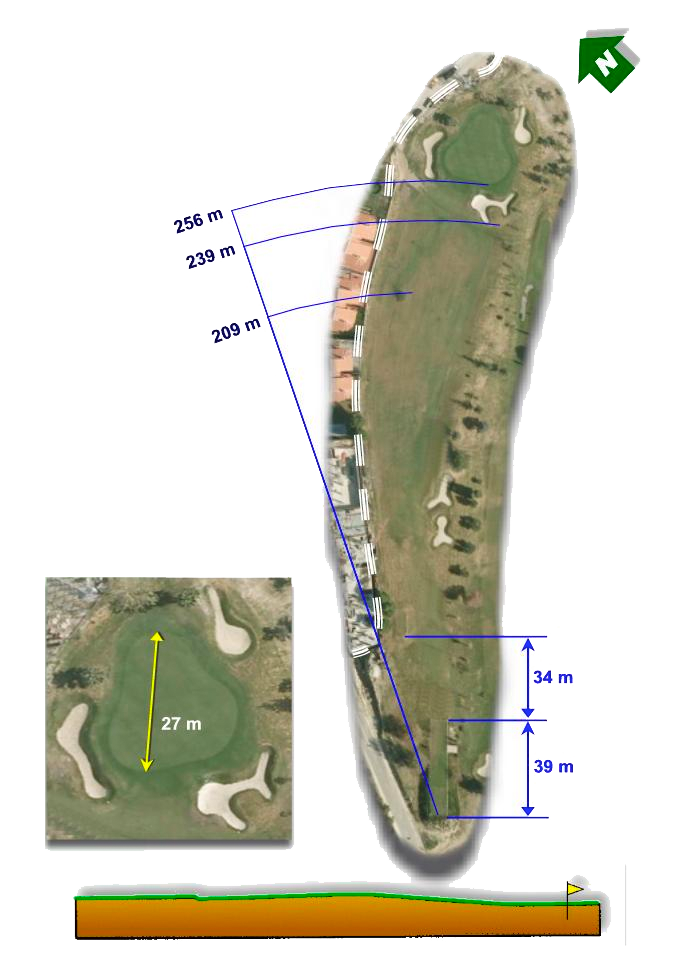
Hole 9
Par four with dog leg to the right. This is another hole to take advantage of, although there is an out of bounds on the left side that in case of closing it too much, in addition to two more strokes, the owner of the glass that you just broke may ask you for the amount of the same and something else that will allow him to put more protective nets. In the event that the tee shot is correct, a downhill slope may bring the green ball closer, in which case only two bunkers, one occupying the entrance on the right side and the other occupying the left side may prevent the deserved recovery of the card.
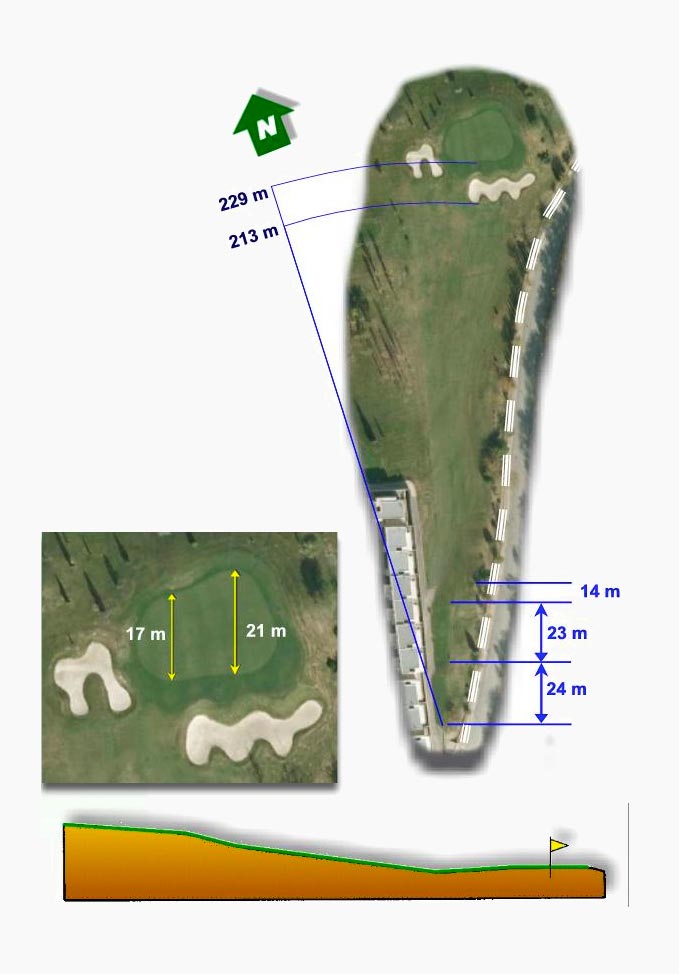
Hole 10
Par three downhill. Not bad to break our comeback schemes. Only 250 meters, a very deep bunker that occupies practically the entire entrance to the green, another one located to the right, small but big enough for us to fall into it and an out of bounds occupying the entire right side of the hole separate us from achieving a par that will not be more par than the one achieved in the previous hole, so… Courage! Perhaps the gorge formed by the two bunkers can save you from disaster.
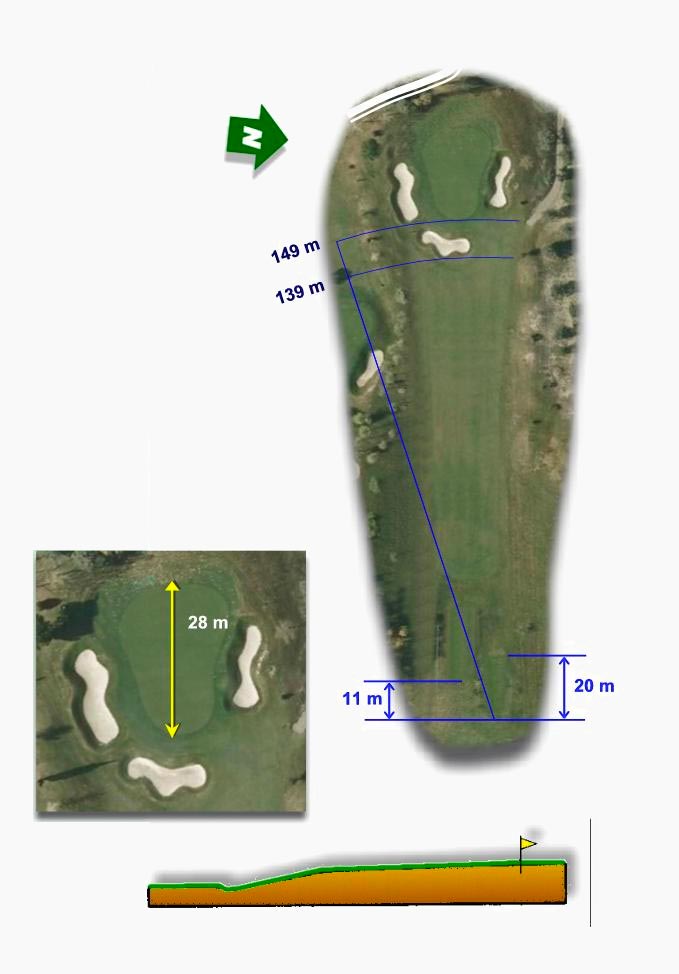
Hole 11
Par three uphill, the one that was missing to totally destroy us. If you have the feeling that you can open the ball, aim more to the left because a bunker to the right of the green and a slope so long that you cannot see the ball fall, full of olive trees, awaits you. In case you are convinced that you can play it straight, you will only have to fight with a bunker located at the entrance and another one that occupies the left side of the green. Ah! Don’t expect a long ball to save you, there is an out of bounds just behind the green.
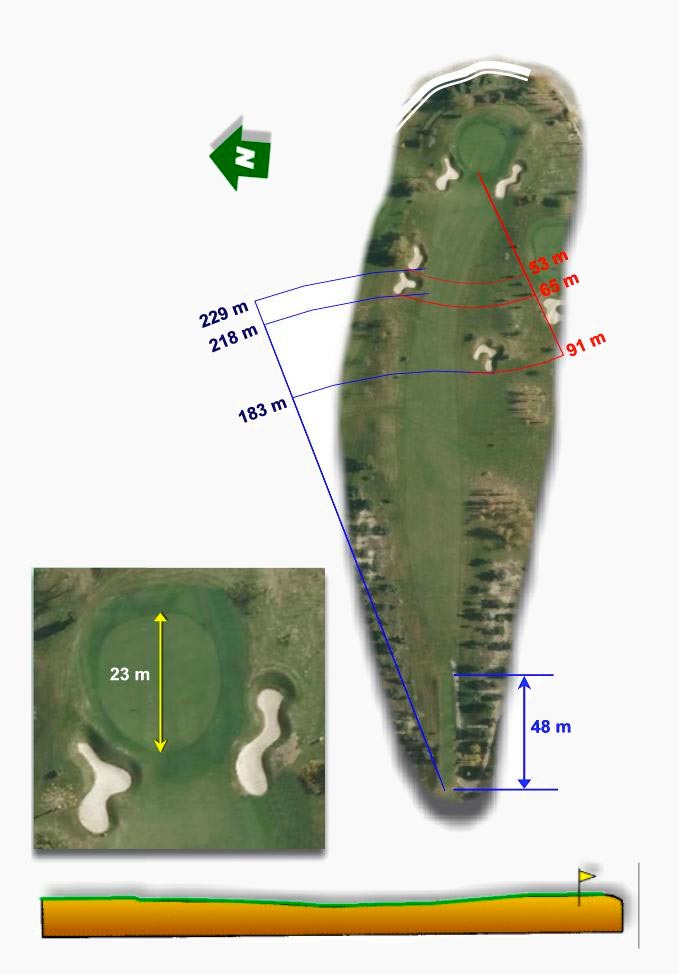
Hole 12
Straight par four. I think we deserve it. A good result on this hole can cut the hemorrhage of bogies. Only two bunkers on the left side of the fairway, another on the right side that will erase the green from our field of vision in case we make the mistake of falling here, another pair of bunkers located on either side of the green, the one on the left being deeper and a poisoned green on this side, separate us from starting the comeback. Behind the green there is a slope that surely does not lead the ball to the metal fence that separates us from the out of bounds, but this should not be a problem, right?
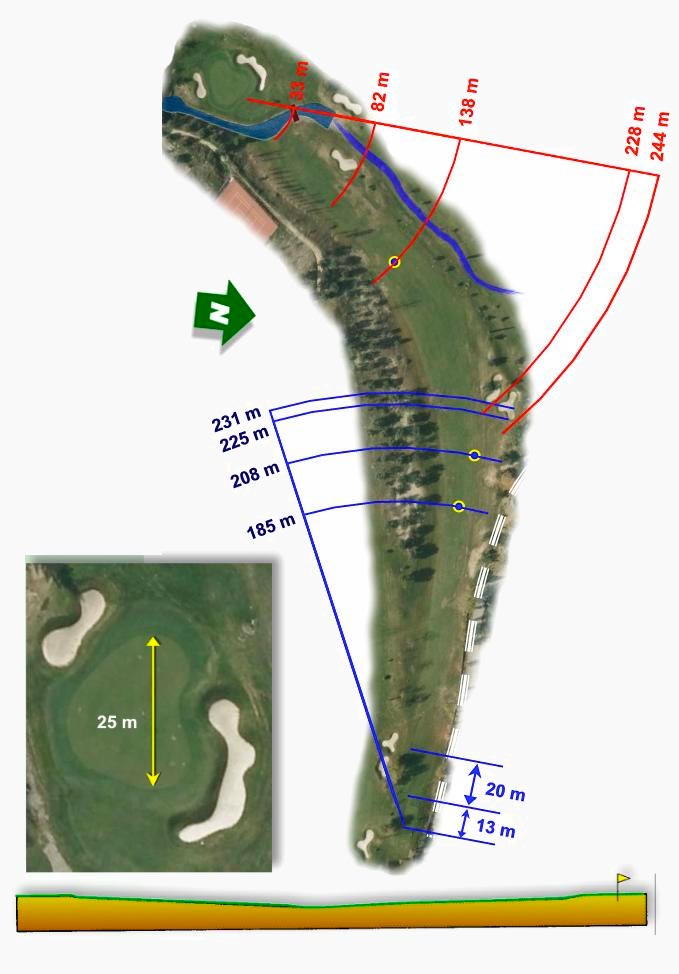
Hole 13
Par five with dog leg to the left. The metal fence will not disappear, at least it will be present at the tee, so be careful with the slice. Two bunkers delimit the fairway on the right side and an area of olive trees on the left side. The dilemma appears on the second shot when we will not know which club to take so that the ball can avoid the bunker on the right side of the fairway, the out of bounds on the left and not reach the front water hazard located at the entrance to the green. In the event that on the second shot you should escape, do not hesitate to hit as much slice as possible so that it stays in the other fairway and not in the lateral water hazard that lurks on the side. On the shot to the green you will find a bunker on the right and another on the left a little too far, better short and on the left? No! Risk of encountering the two-meter snake that, according to legend, lives in the lateral water hazard and apparently feeds on new balls.
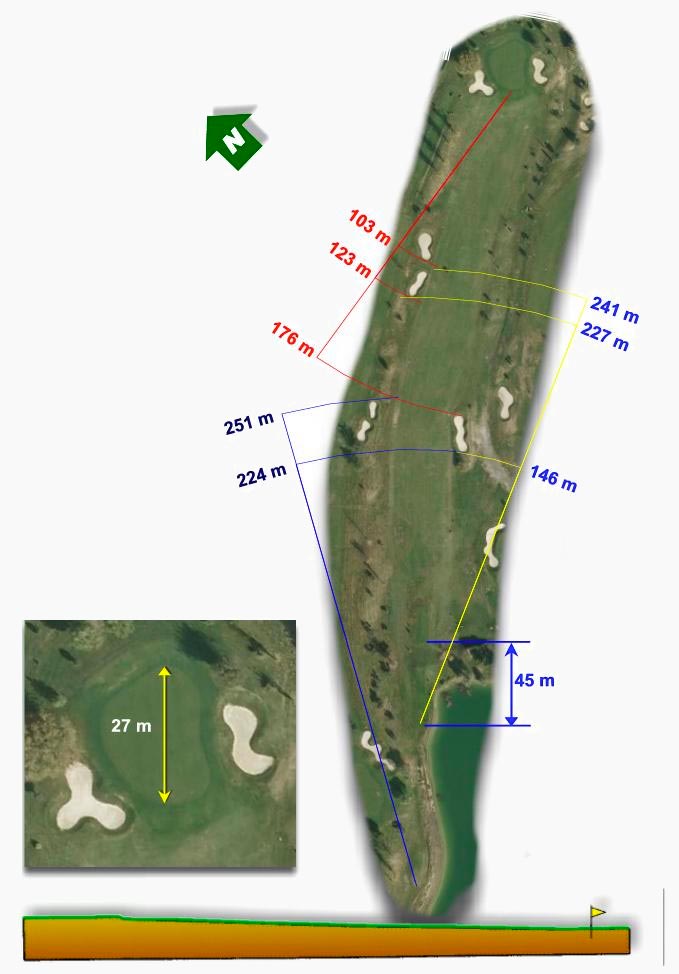
Hole 14
Straight par four. Easy if you have chosen to hit the driver on the left side of the fairway, avoiding the bunker on the right and the lateral water hazard and you have not fallen into the two bunkers located on the left side of the fairway. The shot to the green should not present any problem unless you open it more than necessary, on the right side of the green there is a deep bunker and unless you jump a frog, because at the entrance to the green on the left side there is another bunker a little shallower but no less annoying.
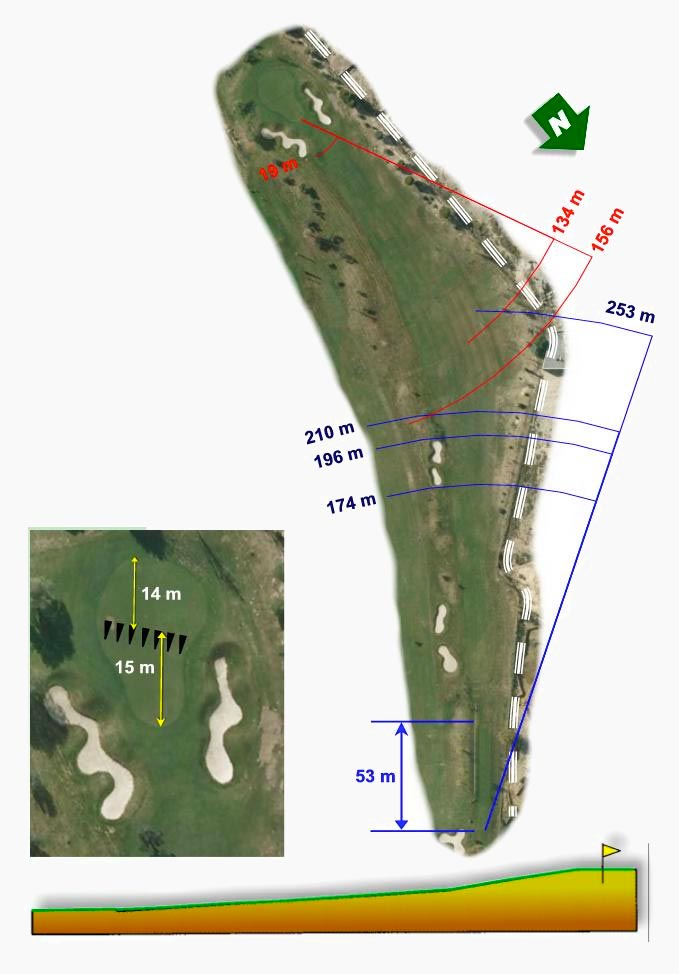
Hole 15
Par four with dog leg left and uphill and as comfortable as we were! Our friend the metal fence greets us all along the right side of this hole without respite, from tee to green. The option is not a slice, but with the draw we find the bunkers that this hole shares with the previous one. What now? My advice is that before hitting, take a last look at the pocket booklet that comes with the golf magazine or ask for divine help. Once on the fairway the second shot is no less easy as it is the only blind green on the course. Short of the green and to the left there is a bunker that according to the statistics takes 2 strokes of each player who visits it, to the right there is another but at height and, you do not see it but on the green there is a piano from side to side that makes the shot and putts even more difficult, I say the, because I do not think you will only make one. If your option is to play to the left of the green and long, do not close it too much because a devilish slope and mowed on purpose will lead you to play a fourth shot with luxury spectators, half-meter marquees.
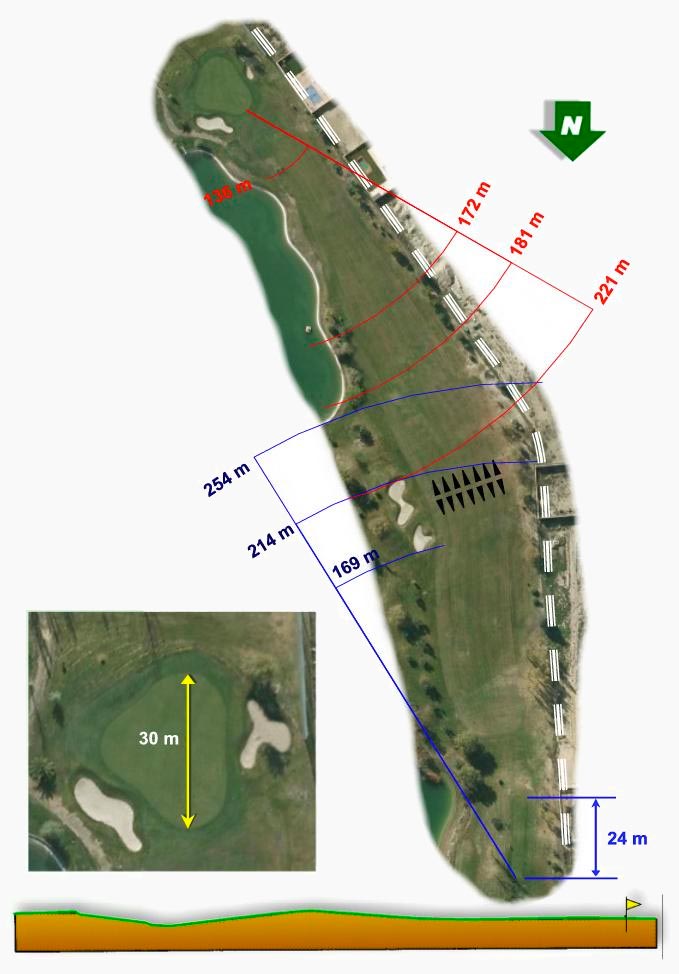
Hole 16
Par four with dog leg left, downhill and without brakes. As you can see our friend the metal fence does not want to miss the great show of bogeis so it will bother you from the beginning to the end. To the left a couple of bunkers whose best resource in case of falling is to take a short stick and take it out to the fairway. Just past the bunker there is a lateral water hazard that will serve as our first contact with our friends, the ducks. It is not all bad news, in case of hitting a good driver a slope can make us believe we are more hitters than usual and bring the ball closer to the green. The green will be protected, on the left by an army of ducks, closer to it, by a bunker that usually turns a blind eye as it is shallow and on the right by another bunker which is advised to enter with a hard hat because of the risk of a ball coming from the driving range, impacting in a fortuitous way? What we were missing…
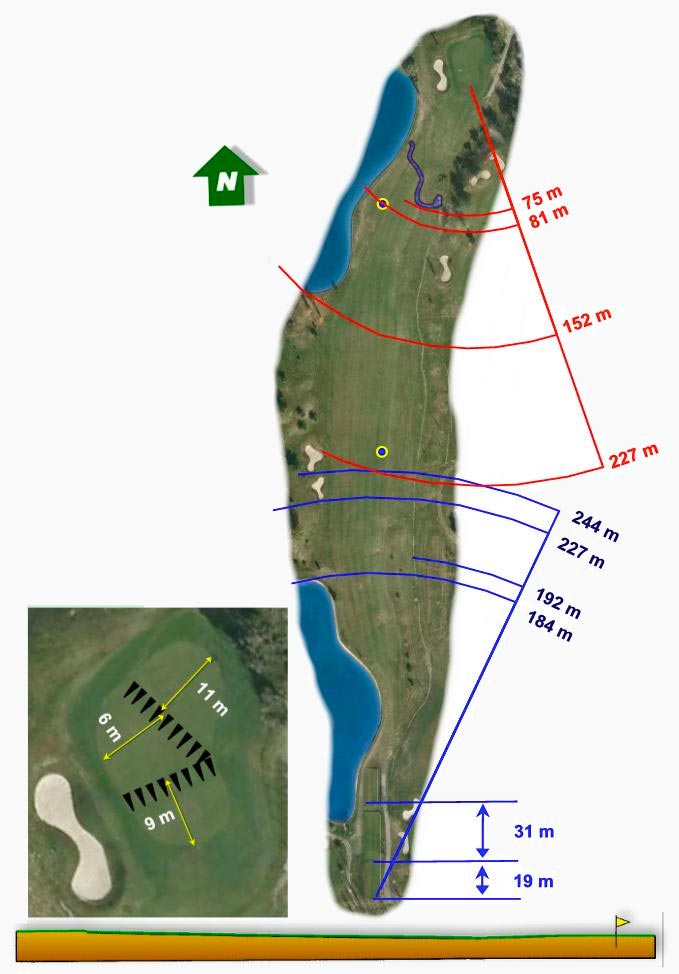
Hole 17
Par five with a slight dogleg to the right. No one would like to kill a duck, but it is much worse to throw a ball into a lateral water hazard on the first shot on a par five, so be careful not to hit the driver back. To the left of the fairway there are two bunkers very close together. Be careful with the second shot as you will have to place the ball between the lateral water hazard inhabited by the carps and another one located on the right, which it is also advisable to enter with the work helmet that we have recently removed, as in this area our bodily integrity depends on the players who hit from the tee of hole 1. The green is protected by a bunker on the left and a slope that leads to the lateral water hazard where the famous snake resides. As if it were a Tribial chip, two pianos divide the green into three triangular parts, the upper one being the smallest and narrowest.
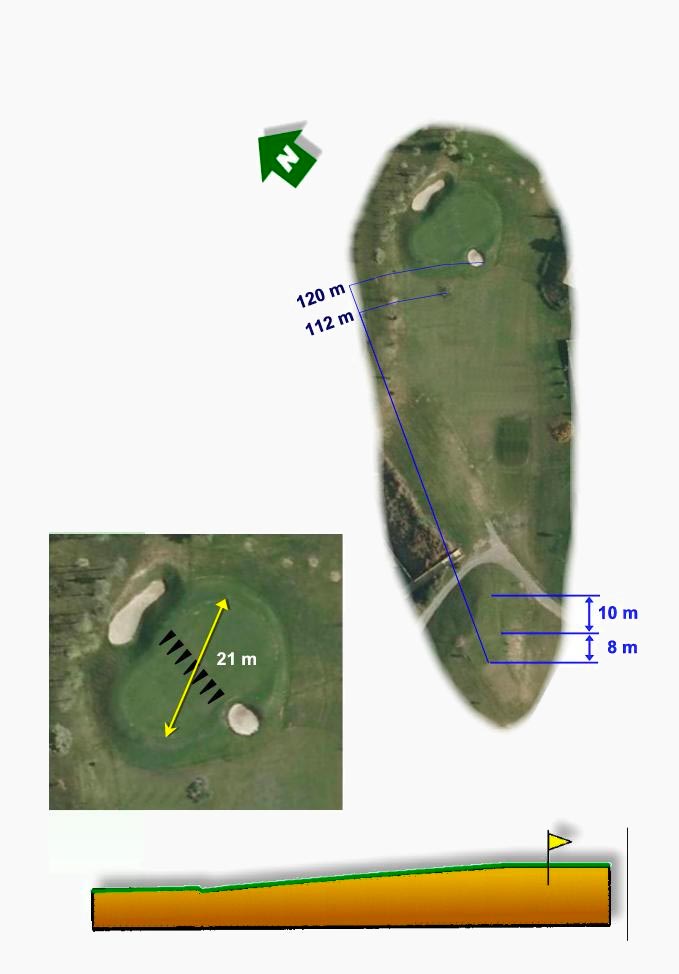
Hole 18
A straight par three of barely 100 meters, sounds good, doesn’t it? It will not be this hole that will give you breath, but the refreshment in the bar once you leave the green. It is the smallest green of the course with a piano that, from the entrance to the back, splits the hole in two, with two totally different strategies. If the flag is on the left, don’t even look at it, focus on the center of the green because the elevation on this side is maximum, and the approach is a matter for experts whether it is short or long in the bunker located at the back. If the flag is on the right, don’t even dream about it, since a very small bunker that will barely allow you to make the swing, prevents us from finishing with a three easily.

Hole 1

Hole 2

Hole 3

Hole 4

Hole 5

Hole 6

Hole 7

Hole 8

Hole 9

Hole 10

Hole 11

Hole 12

Hole 13

Hole 14

Hole 15

Hole 16

Hole 17



